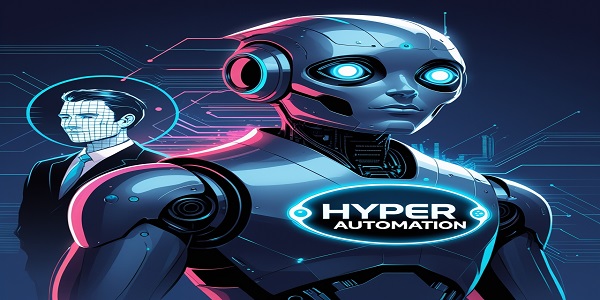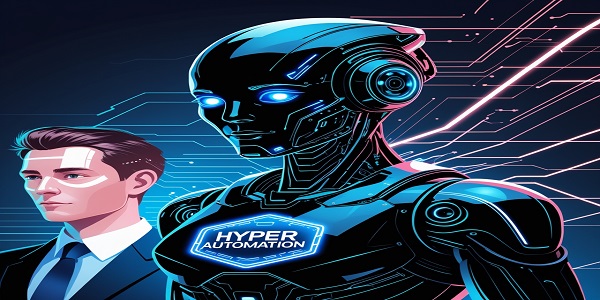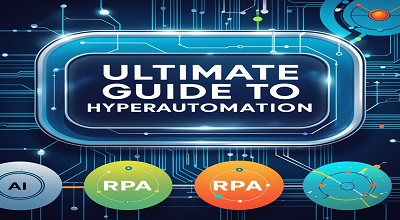Hyperautomation
Hyperautomation: Hyperautomation is the next evolution of business automation, combining Artificial Intelligence (AI), Robotic Process Automation (RPA), and Process Mining to create intelligent, end-to-end automation solutions. Unlike traditional automation, which focuses on rule-based tasks, hyperautomation leverages AI to make decisions, RPA to execute processes, and process mining to optimize workflows.
Gartner named hyperautomation a top strategic technology trend, predicting that by 2025, over 70% of enterprises will adopt hyperautomation to enhance efficiency.
Why is Hyperautomation the Future of Business?
Businesses today face increasing pressure to:
- Reduce operational costs
- Improve accuracy & compliance
- Enhance customer experience
- Scale operations efficiently
Hyperautomation addresses these challenges by automating complex processes, reducing human error, and enabling data-driven decision-making.
Key Components of Hyper automation
- AI & Machine Learning (ML) – Enables cognitive automation, predictive analytics, and decision-making.
- Robotic Process Automation (RPA) – Automates repetitive, rule-based tasks.
- Process Mining – Analyzes workflows to identify inefficiencies and automation opportunities.

The Role of Artificial Intelligence (AI) in Hyper automation
How AI Enhances Automation
AI brings intelligence to automation by:
- Understanding unstructured data (emails, invoices, contracts) using NLP.
- Predicting outcomes (e.g., demand forecasting, fraud detection).
- Learning & improving processes over time.
Machine Learning & NLP in Hyperautomation
- ML algorithms optimize automation by learning from historical data.
- Natural Language Processing (NLP) helps chatbots and virtual assistants understand human language.
AI-Driven Decision Making
AI-powered hyperautomation can:
- Approve loan applications in banking.
- Diagnose medical conditions in healthcare.
- Optimize supply chain logistics.
Robotic Process Automation (RPA) in Hyper automation
What is RPA?
RPA uses software bots to automate repetitive tasks like:
- Data entry
- Invoice processing
- Customer onboarding
How RPA Complements AI
While RPA handles structured tasks, AI processes unstructured data. Together, they enable intelligent automation.
Top RPA Tools for Hyperautomation
- UiPath – Best for enterprise-scale automation.
- Automation Anywhere – Strong in cognitive automation.
- Blue Prism – Focuses on security and compliance.
Process Mining: The Backbone of Hyper automation
What is Process Mining?
Process mining analyzes digital footprints (logs, ERP data) to visualize how processes actually work—not just how they’re supposed to.
How Process Mining Identifies Automation Opportunities
- Detects bottlenecks (e.g., slow approval workflows).
- Uncovers deviations from ideal processes.
- Helps prioritize automation for maximum ROI.
Best Process Mining Tools
- Celonis (Market leader)
- UiPath Process Mining
- Signavio

Benefits of Hyper automation for Businesses
✅ 30-50% cost reduction by eliminating manual work.
✅ 90% fewer errors compared to human processing.
✅ Faster processing times (e.g., invoice processing in minutes vs. days).
✅ Improved compliance with audit trails & regulatory checks.
Hyperautomation Use Cases Across Industries
| Industry | Use Case |
|---|---|
| Banking | Fraud detection, loan processing |
| Healthcare | Patient records automation, diagnostics |
| Manufacturing | Predictive maintenance, supply chain optimization |
| Retail | Chatbots, inventory management |
| Logistics | Route optimization, shipment tracking |
Challenges in Implementing Hyperautomation
- Integration Complexity – Legacy systems may not support AI/RPA.
- Data Security Risks – Automating sensitive processes requires strong governance.
- Employee Resistance – Workforce fears job displacement (though hyperautomation typically augments jobs rather than replaces them).
How to Implement Hyperautomation Successfully?
- Identify Processes – Start with high-volume, repetitive tasks.
- Choose the Right Tools – Pick AI, RPA, and process mining solutions that integrate well.
- Pilot Test – Run small-scale automation before full deployment.
- Monitor & Optimize – Continuously improve using analytics.
Future Trends in Hyper automation (2025 & Beyond)
Self-Learning AI – Systems that improve without human intervention.
Hyperautomation + Edge Computing – Faster real-time automation in IoT devices.
Autonomous Enterprises – Fully automated, self-optimizing businesses.
Conclusion
Hyperautomation (AI + RPA + Process Mining) is transforming businesses by driving efficiency, cutting costs, and enabling smarter decisions. Companies that adopt it now will gain a competitive edge.
At ZoomDoors.com, we help businesses implement hyperautomation seamlessly. Ready to automate your workflows? Contact us today!
FAQs on Hyper automation
1. What’s the difference between RPA and Hyper automation?
RPA automates simple tasks, while hyperautomation combines AI, RPA, and process mining for end-to-end intelligent automation.
2. Which industries benefit most from hyper automation?
Banking, healthcare, manufacturing, and logistics see the highest ROI due to repetitive processes.
3. Is hyper automation expensive to implement?
Initial costs vary, but the long-term efficiency gains justify the investment.
4. Will hyper automation replace jobs?
No—it augments human work by handling repetitive tasks, freeing employees for higher-value work.
5. How does process mining improve hyper automation?
It identifies inefficiencies, helping businesses automate the right processes for maximum impact.
Free Download: Soulmask Game

